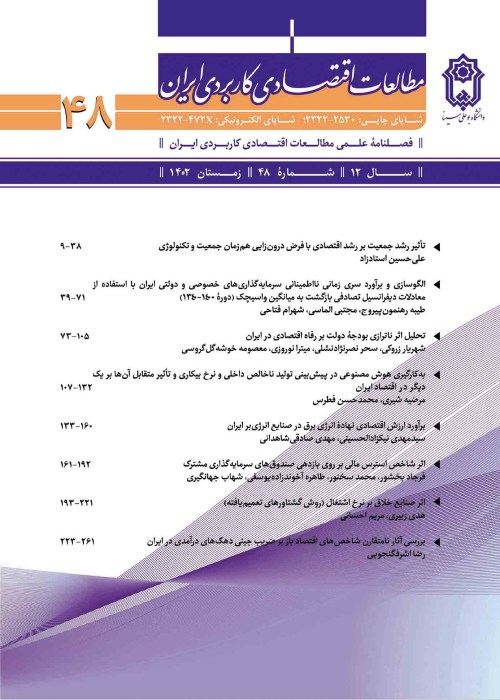Effect of monetary and fiscal shocks on macroeconomic Variables of Iran in different volatility regimes: Markov Switching DSGE Approach
Author(s):
Article Type:
Research/Original Article (دارای رتبه معتبر)
Abstract:
Goal: In an environment where economic structures break, variances change, distributions shift, conventional policies weaken and past events tend to reoccur, economic agents have to form expectations over different regimes. This makes the regime-switching dynamic stochastic general equilibrium model (RS-DSGE) the natural framework for analyzing the dynamics of macroeconomic variables. Therefore, unlike other studies that addressed time-invariant parameters, the present paper analyzed the behavior of the major Iranian economic variables using small open-economy DSGE models and allowing for Markov switching in certain parameters estimated by Bayesian methods.
Methodology
The method proposed by Farmer et al. (2008) was used to solve the MS-DSGE model. The method consists in rewriting the model so that it includes fixed parameters with extended states, whose MSV solution written as an MS-VAR solves the original model. Therefore, this study investigates the effect of monetary and fiscal shocks on macroeconomic variables under different volatility regimes in Iran by applied Markov switching DSGE macroeconometrics approach. In this regard, theoretical framework of New Keynesian Open Economy (NKOE) and quarterly time series data during the period from 1369 to 1393 has been used. The theoretical structure of the model includes five sectors of households, firms, governments, central banks and the foreign economy. Household consumption is divided into two parts of tradeable and non-tradable goods, where tradable goods divided into domestic and foreign goods. Moreover, the firms section separated into two parts of the domestic and foreign firms, where domestic firms are divided into tradable and non-tradable firms. In other hand, foreign firms included three parts of importer, exporter and capital goods. The governments and the Central Bank sectors has been modeled based on the dependence of Iran economy on oil revenues. The foreign economy is modelled as a standard three-equation closed economy DSGE model which is included output, inflation and monetary policy equations.Results
The results of volatility regimes filtering probabilities shows that the variance of monetary and fiscal shocks in three time periods of 1372-1375; 1377-1378, and 1390 to 1393 is greater than other periods that is known as a high-volatilities regime. The influential role of increasing inflation is noteworthy in high volatility periods. Results of impulse response functions reveal that the response of macroeconomic variables to fiscal and monetary impulses in high-volatility regimes is greater than low- volatility regimes. However, it is noteworthy that the intensity of the impulse response functions in high-volatility regimes is short-run, because after a maximum of four periods the reaction of the variables to impulses is very close to the low-volatility regimes. The results of central bank's foreign reserves impulse response function indicated that the production and inflation of tradable goods has been reduction and in contrary, increase of production and inflation of non-tradable goods. Results of government expenditure shock to inflation reveal that the increase of non-tradable and reduce of tradable goods inflation. However, this shock leads to increases production of both goods under consideration. The impulse of government tax revenues has a short-run and little impact on the variables under consideration which that leads to inflation increases and the decline in productions of tradable and non-tradable goods. Eventually, the monetary base shock has the greatest impact on the money supply and also increased other variables under consideration including the production and inflation of tradable and non-tradable goods.Conclusion
According to the dependence of fiscal and monetary policies in Iranian economy on oil revenues, the results implicitly point out the possibility of Dutch disease in Iran. The Dutch disease problem generally refers to a contraction in the industrial or manufacturing tradable sector originating from an increase in the income generated by the export of some commodity that is oil export revenues in Iran. Keywords:
Language:
Persian
Published:
Quarterly Journal of Applied Economics Studiesin Iran, Volume:7 Issue: 25, 2018
Pages:
55 to 83
magiran.com/p1819974
دانلود و مطالعه متن این مقاله با یکی از روشهای زیر امکان پذیر است:
اشتراک شخصی
با عضویت و پرداخت آنلاین حق اشتراک یکساله به مبلغ 1,390,000ريال میتوانید 70 عنوان مطلب دانلود کنید!
اشتراک سازمانی
به کتابخانه دانشگاه یا محل کار خود پیشنهاد کنید تا اشتراک سازمانی این پایگاه را برای دسترسی نامحدود همه کاربران به متن مطالب تهیه نمایند!
توجه!
- حق عضویت دریافتی صرف حمایت از نشریات عضو و نگهداری، تکمیل و توسعه مگیران میشود.
- پرداخت حق اشتراک و دانلود مقالات اجازه بازنشر آن در سایر رسانههای چاپی و دیجیتال را به کاربر نمیدهد.
In order to view content subscription is required
Personal subscription
Subscribe magiran.com for 70 € euros via PayPal and download 70 articles during a year.
Organization subscription
Please contact us to subscribe your university or library for unlimited access!


